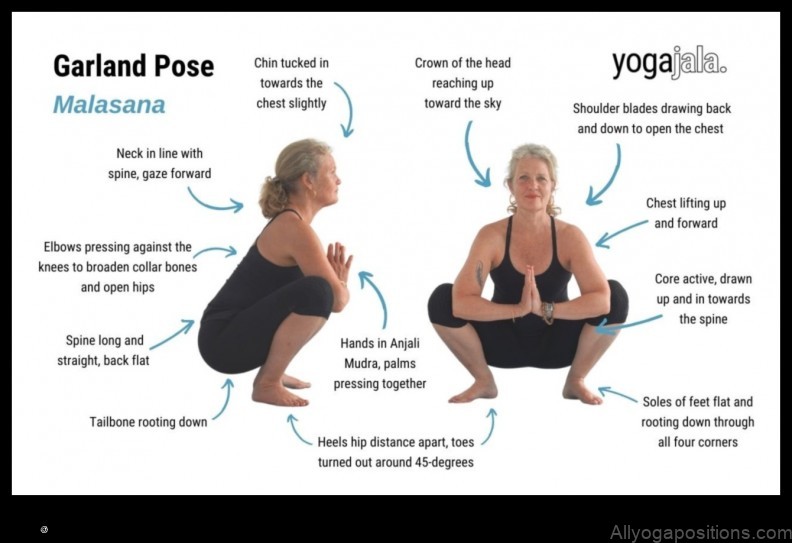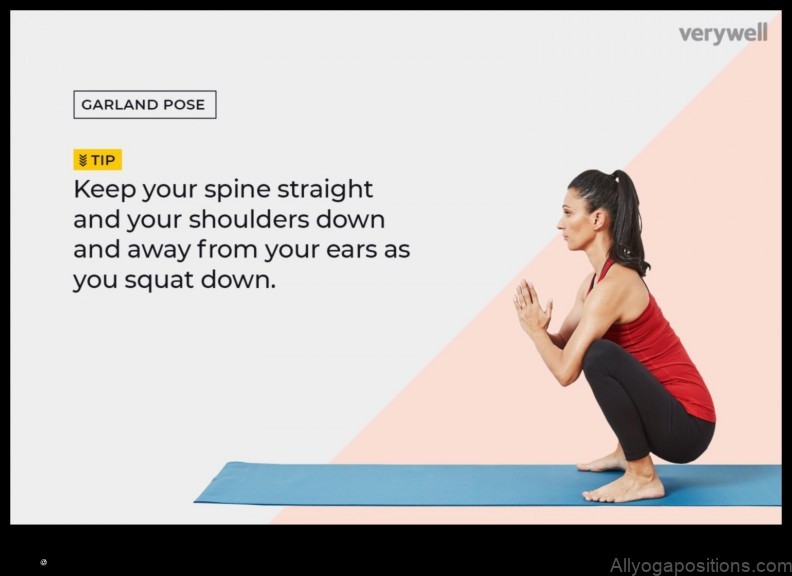
Malasana Yoga Pose
Malasana, also known as the squat pose, is a yoga pose that is said to have many benefits for both physical and mental health. It is a deep squat that stretches the hamstrings, calves, and groin, and it also helps to open the hips and improve flexibility. Malasana is said to be beneficial for digestion, circulation, and stress relief. It is also a good pose for beginners to learn because it is relatively easy to do and it does not require a lot of flexibility.
Here are the steps on how to do Malasana yoga pose:
- Stand with your feet shoulder-width apart.
- Bend your knees and lower your body into a squat.
- Bring your feet together so that your heels are touching.
- Place your hands on your knees or the floor in front of you.
- Inhale and extend your spine.
- Exhale and lower your head towards your knees.
- Hold the pose for 30 seconds to 1 minute.
- To come out of the pose, inhale and raise your body back up to standing.
Here are some precautions for Malasana yoga pose:
- If you have any knee or ankle injuries, be careful not to overextend your joints in this pose.
- If you have high blood pressure, avoid holding this pose for too long.
- If you are pregnant, talk to your doctor before doing this pose.
Here are some modifications for Malasana yoga pose:
- If you cannot bring your feet together in the squat, keep your feet apart.
- If you cannot reach your hands to the floor, place them on your thighs or calves.
- If you have trouble balancing in the squat, hold onto a chair or wall for support.
Here are some common mistakes in Malasana yoga pose:
- Rounding your back in the squat.
- Pushing your knees past your toes.
- Holding the pose for too long.
Malasana yoga pose is a great way to improve your flexibility, strength, and balance. It is also a good pose for relieving stress and improving digestion. If you are new to yoga, talk to your doctor before starting this pose.
Here are some additional benefits of Malasana yoga pose for women, men, and pregnant women:
- For women, Malasana yoga pose can help to relieve menstrual cramps, reduce bloating, and improve fertility.
- For men, Malasana yoga pose can help to improve erectile function and reduce prostate problems.
- For pregnant women, Malasana yoga pose can help to relieve back pain, constipation, and swelling.
Here are some FAQs about Malasana yoga pose:
- Q: What are the benefits of Malasana yoga pose?
- A: Malasana yoga pose has many benefits for both physical and mental health. It is said to help with digestion, circulation, stress relief, and flexibility. It is also a good pose for beginners to learn because it is relatively easy to do and it does not require a lot of flexibility.
- Q: What are the precautions for Malasana yoga pose?
- A: If you have any knee or ankle injuries, be careful not to overextend your joints in this pose. If you have high blood pressure, avoid holding this pose for too long. If you are pregnant, talk to your doctor before doing this pose.
- Q: What are some modifications for Malasana yoga pose?
- If you cannot bring your feet together in the squat, keep your feet apart. If you cannot reach your hands to the floor, place them on your thighs or calves. If you have trouble balancing in the squat, hold onto a chair or wall for support.
Malasana Yoga A yoga pose A mind and body practice A squat A type of exercise A stretch An exercise that lengthens muscles Flexibility The ability to move your joints through a full range of motion 
What is Malasana Yoga Pose?
Malasana yoga pose, also known as the squat pose, is a deep seated forward bend that is said to open the hips, stretch the groin, and strengthen the legs. It is a popular pose in hatha yoga and is often used as a warm-up before more challenging poses.
Malasana is a challenging pose, but it is also very beneficial. It can help to improve flexibility, balance, and strength. It can also help to relieve stress and anxiety.
If you are new to yoga, it is important to start practicing Malasana slowly and with caution. Listen to your body and do not push yourself too hard.
III. How to Do Malasana Yoga Pose
To do Malasana yoga pose, follow these steps:
- Start by standing with your feet hip-width apart.
- Bend your knees and lower your hips down as if you were sitting in a chair.
- Place your hands on the floor in front of you, shoulder-width apart.
- Inhale and extend your arms forward, reaching your fingertips toward the ground.
- Exhale and fold forward, bringing your torso over your legs.
- Rest your forehead on the ground or on your shins.
- Hold the pose for 30 seconds to 1 minute, breathing deeply.
- To come out of the pose, inhale and lift your torso up.
- Exhale and straighten your legs.
- Stand up and shake your body to release any tension.

II. Benefits of Malasana Yoga Pose
Malasana yoga pose has many benefits, including:
- Improves flexibility
- Strengthens the legs, hips, and ankles
- Opens the hips and groin
- Relieves stress and anxiety
- Improves digestion
- Reduces lower back pain
- Helps to relieve menstrual cramps
- Promotes relaxation
V. Modifications for Malasana Yoga Pose
If you are unable to do the full Malasana pose, there are a few modifications that you can try.
- Start by sitting on your heels with your toes together.
- Place your hands on your knees or thighs.
- Inhale and reach your arms up overhead.
- Exhale and fold forward, bringing your forehead to your knees.
- Hold the pose for a few breaths, then release and come back to sitting.
Another modification is to place a block or folded blanket under your heels. This will help to relieve pressure on your knees.
If you have any pain in your knees, hips, or back, it is important to listen to your body and stop if you feel any discomfort.
VI. Common Mistakes in Malasana Yoga Pose
There are a few common mistakes that people make when doing Malasana yoga pose. These mistakes can make the pose less effective and increase the risk of injury.
- Not spreading the knees wide enough. When you do Malasana, your knees should be spread wide enough so that your feet are flat on the ground. If your knees are too close together, you will not be able to get your hips as low as you need to, and you will put more stress on your knees.
- Not bending your knees enough. You should bend your knees as much as you need to in order to get your hips as low as possible. If you don’t bend your knees enough, you will not be able to get the full benefits of the pose.
- Rounding your back. When you do Malasana, your back should be straight. If you round your back, you will put strain on your spine.
- Leaning too far forward. When you do Malasana, you should lean forward from your hips, not from your waist. If you lean too far forward, you will put strain on your lower back.
- Holding the pose for too long. Malasana is a challenging pose, and it is important not to hold it for too long. If you hold the pose for too long, you will fatigue your muscles and increase your risk of injury.
If you are new to yoga, it is important to start with a modified version of Malasana. This will help you to learn the proper form of the pose and avoid injury. As you get stronger and more flexible, you can gradually progress to the full version of the pose.
VII. Benefits of Malasana Yoga Pose for Women
Malasana yoga pose has many benefits for women, including:
- Reduces menstrual cramps
- Relieves stress and anxiety
- Improves digestion
- Strengthens the pelvic floor
- Increases flexibility
- Helps with childbirth
If you are pregnant, be sure to talk to your doctor before practicing Malasana yoga pose.
Benefits of Malasana Yoga Pose for Men
Malasana yoga pose offers a number of benefits for men, including:
- Improved flexibility
- Increased range of motion
- Strengthened core muscles
- Reduced stress and anxiety
- Improved posture
- Increased circulation
- Reduced pain
- Enhanced relaxation
If you are a man looking for a yoga pose that can provide you with a variety of benefits, Malasana is a great option. It is a relatively simple pose that can be modified to suit your individual needs and abilities.
To do Malasana, start by standing with your feet shoulder-width apart. Bend your knees and lower your body into a squat, keeping your heels on the ground. Bring your hands together in front of your chest or rest them on your thighs. Hold the pose for 30 seconds to 1 minute, then slowly come back up to standing.
Malasana can be done as part of a yoga practice or on its own. If you are new to yoga, it is important to start slowly and gradually increase the length of time you hold the pose. If you experience any pain, stop and consult with a doctor or certified yoga instructor.
IX. Benefits of Malasana Yoga Pose for Pregnant Women
Malasana yoga pose can be beneficial for pregnant women in a number of ways. It can help to:
- Reduce back pain
- Relieve swelling in the legs
- Improve circulation
- Ease constipation
- Increase flexibility
- Prepare the body for labor
However, it is important to talk to your doctor before doing Malasana yoga pose if you are pregnant, as there are some precautions that you should take.
FAQs About Malasana Yoga Pose
Q: What is Malasana Yoga Pose?
A: Malasana Yoga Pose, also known as Squat Pose or Garland Pose, is a seated forward bend that is said to resemble a flower blooming. It is a great pose for stretching the hips, thighs, and groin, and it is also said to help relieve stress and anxiety.
Q: What are the benefits of Malasana Yoga Pose?
A: Malasana Yoga Pose offers a number of benefits, including:
* Stretches the hips, thighs, and groin
* Improves flexibility
* Relieves stress and anxiety
* Helps with digestion
* Improves circulation
* Reduces pain in the lower backQ: What are the precautions for Malasana Yoga Pose?
A: There are a few precautions to take when practicing Malasana Yoga Pose, including:
* If you have any knee or ankle injuries, avoid this pose or modify it as needed.
* If you have high blood pressure, practice this pose with caution.
* If you are pregnant, avoid this pose or modify it as needed.Table of Contents
Maybe You Like Them Too
